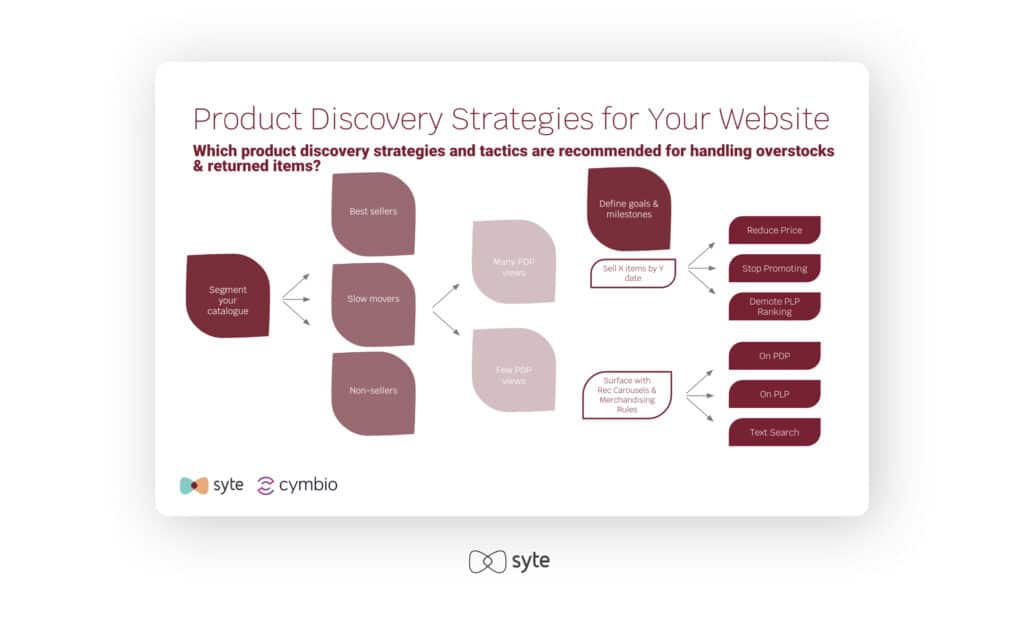Post-BFCM (Black Friday Cyber Monday), chances are your brand has been left with overstock and returned items. With 2023 around the corner, you may be left wondering which tools you can use to reduce last season’s inventory and increase eCommerce efficiencies. Artificial Intelligence (AI) and automation — including product tagging, visual search, and drop ship operations — are proven technologies to help your brand prepare for the upcoming new year.
In our recent webinar, Syte Senior Customer Success Manager Aaron Ellis and Cmybio Customer Success Manager Lauren Silvermintz discussed how to better understand your catalog and take scalable action by segment. They also delved into how to optimize and allocate inventory according to each sales channel and how to leverage AI-based product tagging to hone demand forecasting.
Watch Webinar
Know Your “Why” and “Where”
When it comes to managing inventory, pre-planning is essential. To handle both overstock and out-of-stock scenarios, it all boils down to the “Why” and “Where.” As Aaron explained, the “Why” is about knowing when and how you’re selling which products, segmenting your catalogue, and setting goals and expiry dates. Lauren covered the “Where,” which involves connecting to various dropship and marketplace outlets, enabling a multichannel inventory strategy and visibility into end-to-end eCommerce flows.
“I think one of the things we’re constantly working to improve is efficiency and balancing that with scalability. So, how do we manage a lot of items with our limited amount of time? The best way we can do that is by segmenting our catalogue,” Aaron said.
Brands and retailers should identify best-sellers, slow-moving products, and non-sellers, he recommended. Once the segments are sorted, one can look at which segments are getting many PDP (product detail page) views vs low PDP views. If items are non-sellers and don’t have PDP views, the situation can be remedied by merchandising those items across the website real estate (e.g., PDPs, Recommendation Carousels, PLPs, text search pages, etc.).
If, on the other hand, products are not selling well despite receiving many views, brands should investigate further. In this case, Aaron added, push overstock items to areas where they’ll get views such as the top three PLPs (product listing pages) and in recommendation carousels. You can also place complementary overstock products within recommendation carousels listed on best-seller PDPs to get better traction and move inventory more quickly. It’s important to ensure that recommended items are in stock, he said, so as not to inadvertently lead buyers to dead-ends.

Set Your Inventory Expiration Date
“The ideal goal of what you want to achieve is to understand how quickly you’re moving products, or the velocity: how many orders per day, per week, or per month for a specific item, and how long you have to sell out that product within your website,” Aaron explained.
Once establishing the desired sell-through rate, brands, retailers and marketplaces can monitor product performance and take action based on that. It could be in the form of increased marketing spending or reduced product prices. Whatever it may be, inventory should have an expiration date. Once brands know how to understand and adjust their merchandising strategies, it’s easier to replicate the strategies that are performing well.
Have a Multichannel Approach
“Inventory for a brand is your biggest asset. It’s your currency. It’s what you’re selling. It is your product, but it’s also your biggest liability. Sitting on a pool of inventory that’s not liquidating or turning over is a real liability for a brand to have,” Lauren said.
Inventory should always be an asset, not a liability, she emphasized. To this effect, having a multichannel strategy in which brands sell through multiple retailers or marketplaces or explore a drop-ship approach is key. “If you have best-sellers, make sure they don’t sell out.”
Boost Product Discovery Through AI
AI tagging is an automated process that enables us to take images and enrich them through detailed product descriptions. These tags are the foundation of discoverability on any eCommerce website and turn up accurate results for shoppers. If a tag is not there, shoppers simply won’t find it in visual or text search.
“Having a strong, accurate foundation will get you the first step of the way for overstock items, making sure that all your products have a fair playing field. Everything is discoverable now — not just from your text, but on your PLP pages in the correct areas, and through your recommendation engines,” Aaron explained.
In Summary
Having overstock is not a dead-end. There are various ways to dig deeper into why brands, retailers and marketplaces are left with excess inventory. These include segmenting one’s catalogue, using merchandising rules and strategies, setting stock expiration dates, and selling through multiple channels.
By leveraging AI and automation, brands will be better equipped to understand how inventory is moving, take the information to plan for next season, and set up a strategy for better sell-through rates.
Watch Webinar